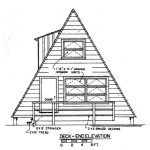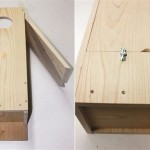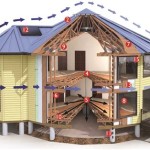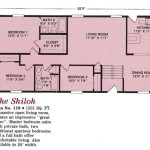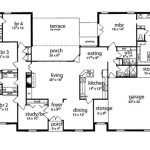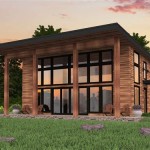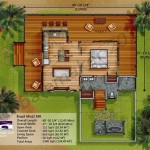Pacific Northwest house plans are architectural blueprints specifically designed to suit the unique climatic conditions and aesthetic preferences of the Pacific Northwest region of the United States. These plans typically incorporate elements such as steeply pitched roofs, large windows, and expansive decks to maximize natural light and outdoor living space. One notable example of a Pacific Northwest house plan is the iconic Northwest Contemporary style, which emphasizes clean lines, open floor plans, and a connection to nature.
The popularity of Pacific Northwest house plans stems from their ability to blend seamlessly with the region’s stunning natural surroundings. By incorporating elements that complement the area’s climate and landscape, these plans create homes that are both functional and aesthetically pleasing. As the demand for sustainable and energy-efficient living continues to grow, Pacific Northwest house plans have become increasingly sought-after, offering a harmonious balance between comfort and environmental consciousness.
In this article, we will explore the various aspects of Pacific Northwest house plans. We will delve into their design principles, examine the different styles available, and discuss the factors to consider when choosing a plan that best fits your needs. Whether you are a homeowner looking to build a new home or a design professional seeking inspiration, this comprehensive guide will provide you with valuable insights into the world of Pacific Northwest house plans.
Pacific Northwest house plans stand out with their distinctive characteristics, tailored to the region’s unique climate and aesthetic preferences. Here are eight key points to consider:
- Steeply pitched roofs
- Large windows
- Expansive decks
- Open floor plans
- Natural materials
- Energy efficiency
- Sustainable design
- Connection to nature
These elements combine to create homes that are both functional and aesthetically pleasing, seamlessly blending with the region’s stunning natural surroundings.
Steeply pitched roofs
Steeply pitched roofs are a defining characteristic of Pacific Northwest house plans, playing a crucial role in managing the region’s abundant rainfall. These roofs are designed with a slope of 45 degrees or more, allowing water to shed quickly and efficiently, preventing leaks and damage to the home’s structure.
- Protection from the elements: Steeply pitched roofs provide excellent protection from rain, snow, and wind. The steep slope ensures that water and snow slide off the roof quickly, minimizing the risk of leaks and water damage.
- Ventilation: The high peak of steeply pitched roofs allows for proper ventilation, which is essential for maintaining a comfortable indoor environment. The airflow helps to regulate temperature and reduce moisture buildup, preventing mold and mildew growth.
- Energy efficiency: Steeply pitched roofs can contribute to energy efficiency by providing space for insulation. The additional attic space allows for proper insulation, which helps to keep the home warm in winter and cool in summer, reducing energy consumption.
- Aesthetic appeal: In addition to their functional benefits, steeply pitched roofs also add to the aesthetic appeal of Pacific Northwest homes. The dramatic lines and angles create a visually striking silhouette that complements the region’s natural surroundings.
Overall, steeply pitched roofs are an integral part of Pacific Northwest house plans, offering a combination of protection, ventilation, energy efficiency, and aesthetic charm.
Large windows
Large windows are a prominent feature of Pacific Northwest house plans, playing a crucial role in connecting the indoors with the outdoors and maximizing natural light.
- Connection to nature: Large windows provide expansive views of the surrounding natural beauty, creating a seamless connection between the indoors and the outdoors. This connection to nature enhances the overall living experience, promoting a sense of tranquility and well-being.
- Natural light: The abundant windows allow for ample natural light to flood into the home, reducing the need for artificial lighting. Natural light has numerous benefits, including improving mood, boosting energy levels, and regulating circadian rhythms.
- Energy efficiency: Large windows can contribute to energy efficiency when combined with proper insulation and glazing. By utilizing natural light, the need for artificial lighting is reduced, leading to lower energy consumption.
- Aesthetic appeal: Large windows add to the aesthetic appeal of Pacific Northwest homes. The expansive glass panes create a modern and inviting look, while framing the stunning views of the surrounding landscape.
Overall, large windows are a defining characteristic of Pacific Northwest house plans, offering a combination of connection to nature, natural light, energy efficiency, and aesthetic beauty.
Expansive decks
Expansive decks are a hallmark of Pacific Northwest house plans, extending the living space outdoors and creating a seamless connection with the surrounding natural environment.
- Outdoor living: Expansive decks provide ample space for outdoor living and entertaining. Whether it’s hosting barbecues, relaxing in the sunshine, or simply enjoying the fresh air, decks offer a versatile space to connect with nature and enjoy the outdoors.
- Connection to nature: Decks extend the living space outdoors, allowing homeowners to fully immerse themselves in the beauty of their surroundings. Decks provide a front-row seat to stunning views, whether it’s a lush forest, a sparkling lake, or a breathtaking mountain range.
- Entertainment and relaxation: Expansive decks offer a perfect setting for entertaining guests or simply relaxing and enjoying the outdoors. Decks can be furnished with comfortable seating, outdoor kitchens, and fire pits, creating a welcoming and inviting space for gatherings or personal leisure.
- Increased home value: Expansive decks can add significant value to a home. Decks are highly sought-after features by potential buyers, as they extend the living space and enhance the overall enjoyment of the property.
Overall, expansive decks are an integral part of Pacific Northwest house plans, offering a seamless connection to nature, additional outdoor living space, increased home value, and endless opportunities for entertainment and relaxation.
Open floor plans
Open floor plans are a defining feature of Pacific Northwest house plans, creating a spacious and inviting living environment that seamlessly connects different functional areas.
- Spaciousness and flow: Open floor plans eliminate traditional walls and barriers between living spaces, creating a sense of spaciousness and fluidity. This allows for easy movement and interaction between different areas, fostering a more social and connected living experience.
- Natural light: Open floor plans allow for ample natural light to penetrate deep into the home. By removing walls and partitions, windows and doors can be strategically placed to maximize daylighting, reducing the need for artificial lighting and creating a brighter and more welcoming atmosphere.
- Flexibility and customization: Open floor plans offer a high degree of flexibility and customization. The absence of fixed walls allows homeowners to arrange and rearrange furniture and spaces to suit their changing needs and preferences, creating a truly personalized living environment.
- Connection to nature: Open floor plans often incorporate large windows and expansive decks, blurring the boundaries between indoor and outdoor spaces. This connection to nature enhances the overall living experience and promotes a sense of well-being.
Overall, open floor plans are highly sought-after in Pacific Northwest house plans, offering a combination of spaciousness, natural light, flexibility, and connection to nature, creating a comfortable and inviting living environment.
Natural materials
Pacific Northwest house plans often incorporate natural materials, which blend harmoniously with the region’s natural surroundings and create a warm and inviting living environment.
- Wood: Wood is a predominant natural material used in Pacific Northwest house plans. Its versatility and durability make it suitable for a variety of applications, including siding, roofing, flooring, and cabinetry. Wood also adds warmth and character to a home, creating a cozy and inviting atmosphere.
- Stone: Stone is another popular natural material used in Pacific Northwest house plans. Its strength and durability make it ideal for exterior applications such as patios, walkways, and retaining walls. Stone also adds a touch of elegance and sophistication to a home’s exterior.
- Glass: Glass is a key natural material used in Pacific Northwest house plans to maximize natural light and create a connection to the outdoors. Large windows and expansive decks allow homeowners to enjoy stunning views of the surrounding landscape and bring the beauty of nature into their homes.
- Metal: Metal accents, such as copper gutters and steel beams, are often incorporated into Pacific Northwest house plans to add durability and a modern touch. Metal elements can complement the natural materials used in the home’s exterior and create a visually striking contrast.
Overall, the use of natural materials in Pacific Northwest house plans reflects a deep appreciation for the region’s natural beauty and a desire to create homes that are both aesthetically pleasing and environmentally conscious.
Energy efficiency
Pacific Northwest house plans prioritize energy efficiency, incorporating design elements and systems that minimize energy consumption and reduce environmental impact.
- Insulation: Proper insulation is crucial in Pacific Northwest house plans to minimize heat loss during the winter and heat gain during the summer. Walls, ceilings, and floors are insulated with high-performance materials, such as fiberglass, cellulose, or spray foam, to create a thermal barrier and maintain a comfortable indoor temperature.
- Windows and doors: Energy-efficient windows and doors are essential to reduce heat loss and air infiltration. Double- or triple-glazed windows with low-emissivity (Low-E) coatings help insulate the home, while weatherstripping and tight seals around doors and windows prevent drafts.
- Heating and cooling systems: Pacific Northwest house plans often incorporate energy-efficient heating and cooling systems, such as heat pumps or radiant floor heating. Heat pumps provide both heating and cooling, while radiant floor heating evenly distributes warmth throughout the home, reducing energy consumption.
- Appliances and lighting: Energy-efficient appliances and lighting fixtures can significantly reduce energy use in a home. Pacific Northwest house plans encourage the use of ENERGY STAR-rated appliances, which meet strict energy-efficiency standards, and LED lighting, which consumes less energy and lasts longer than traditional bulbs.
By incorporating these energy-efficient measures, Pacific Northwest house plans not only reduce energy costs and environmental impact but also enhance the comfort and well-being of homeowners by maintaining a consistent and comfortable indoor temperature throughout the year.
Sustainable design
Sustainable design is a fundamental principle of Pacific Northwest house plans, emphasizing the use of environmentally friendly materials and practices to minimize environmental impact and promote a healthier living environment.
- Energy efficiency: As discussed earlier, energy efficiency is a cornerstone of sustainable design in Pacific Northwest house plans. Incorporating energy-efficient measures, such as insulation, energy-efficient windows and doors, and heating and cooling systems, significantly reduces energy consumption and lowers greenhouse gas emissions.
Moreover, Pacific Northwest house plans often utilize passive solar design principles to harness natural energy sources. Large windows and proper building orientation allow for maximum sunlight penetration during winter, reducing the need for artificial heating. Overhangs and awnings provide shade during summer, minimizing heat gain and the need for air conditioning.
- Water conservation: Pacific Northwest house plans prioritize water conservation through the use of low-flow fixtures and appliances. Water-efficient toilets, faucets, and showerheads reduce water consumption without compromising comfort or functionality. Additionally, rainwater harvesting systems are often incorporated to collect and store rainwater for irrigation or other non-potable uses.
- Sustainable materials: Pacific Northwest house plans emphasize the use of sustainable and recycled materials. Wood from sustainably managed forests, bamboo flooring, and recycled glass countertops are examples of eco-friendly materials that minimize environmental impact. These materials not only reduce the carbon footprint of the home but also contribute to a healthier indoor environment by reducing the release of harmful chemicals.
- Indoor air quality: Pacific Northwest house plans prioritize indoor air quality by incorporating design elements and materials that promote a healthy living environment. Proper ventilation systems ensure adequate air exchange, reducing the accumulation of pollutants and allergens. Low-VOC (volatile organic compound) paints, finishes, and flooring materials minimize the release of harmful chemicals into the indoor air, creating a healthier and more comfortable living space.
Overall, sustainable design in Pacific Northwest house plans encompasses a holistic approach to minimize environmental impact, conserve resources, and promote the health and well-being of homeowners. By embracing sustainable practices and incorporating eco-friendly materials, these homes not only reduce their carbon footprint but also create a healthier and more comfortable living environment.
Connection to nature
Pacific Northwest house plans are renowned for their seamless connection to nature, creating a harmonious blend between indoor and outdoor living. This connection is achieved through thoughtful design elements that maximize natural light, frame stunning views, and provide easy access to outdoor spaces.
- Expansive windows and doors: Large windows and expansive glass doors are a hallmark of Pacific Northwest house plans. These openings allow for ample natural light to flood the home, reducing the need for artificial lighting and creating a brighter, more inviting atmosphere. Moreover, they provide unobstructed views of the surrounding landscape, bringing the beauty of nature into the living space.
- Indoor-outdoor flow: Pacific Northwest house plans often incorporate open floor plans that seamlessly connect interior and exterior spaces. Large sliding doors or bi-fold doors open up the home, extending the living area outdoors onto decks, patios, or courtyards. This seamless flow allows for effortless transitions between indoor and outdoor activities, fostering a closer connection to nature.
- Natural materials: Pacific Northwest house plans frequently utilize natural materials, such as wood, stone, and glass, to create a warm and inviting atmosphere that complements the natural surroundings. These materials blend harmoniously with the landscape, reducing the visual impact of the home and promoting a sense of unity with nature.
- Outdoor living spaces: Pacific Northwest house plans place great emphasis on outdoor living spaces, such as decks, patios, and courtyards. These spaces extend the living area outdoors, providing homeowners with opportunities to relax, entertain, or simply enjoy the beauty of their surroundings. By incorporating outdoor living spaces, Pacific Northwest house plans create a seamless connection between the indoors and the outdoors, fostering a closer relationship with nature.
The connection to nature in Pacific Northwest house plans extends beyond aesthetic considerations. It fosters a deeper appreciation for the natural environment, promoting a healthier and more sustainable lifestyle. By embracing the beauty and tranquility of their surroundings, homeowners can experience a greater sense of well-being and a renewed connection to the natural world.










Related Posts

